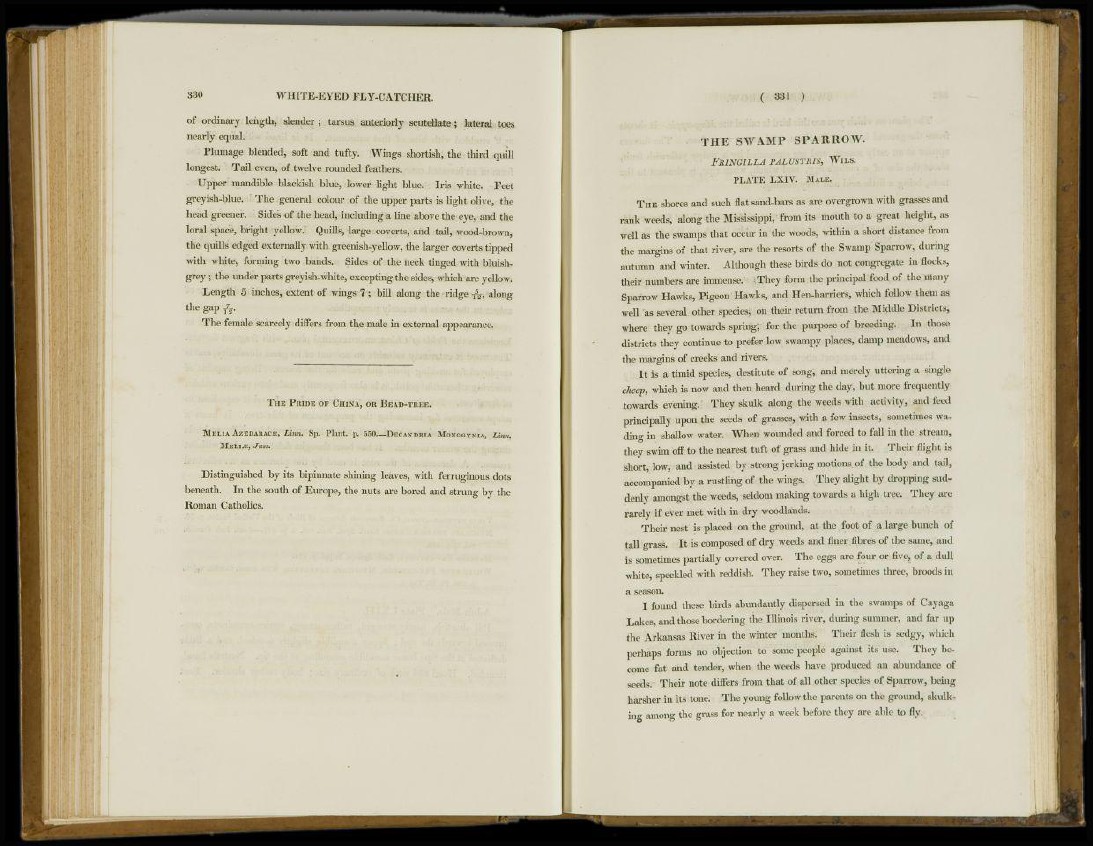
330 WHITE-EYED FLY-CATCHER.
of ordinary length, slender ; tarsus anteriorly scutellate ; lateral toes
nearly equal.
Plumage blended, soft and tufty. Wings shortish, the third quill
longest. Tail even, of twelve rounded feathers.
Upper mandible blackish blue, lower light blue. Iris white. Feet
greyish-blue. The general colour of the upper parts is light olive, the
head greener. Sides of the head, including a line above the eye, and the
loral space, bright yellow. Quills, large coverts, and tail, wood-brown,
the quills edged externally with greenish-yellow, the larger coverts tipped
with white, forming two bands. Sides of the neck tinged with bluishgrey
; the under parts greyish-white, excepting the sides, which are yellow;
Length 5 inches, extent of wings 7 ; bill along the ridge fa along
the gap fa
The female scarcely differs from the male in external appearance.
THE PIUDE OF CHINA, OR BEAD-TREE.
MELIA AZEDAKACH, Linn. Sp. Plant, p, 550.—DECANDRIA MONOGYXIA, Linn.
MELIJE, JUSS.
Distinguished by its bipinnate shining leaves, with ferruginous dots
beneath. In the south of Europe, the nuts are bored and strung by the
Roman Catholics.
( 331 )
THE SWAMP SPARROW.
FRINGILLA PALUSTRIS, WILS.
PLATE L X I V . MALE.
THE shores and such flat sand-bars as are overgrown with grasses and
rank weeds, along the Mississippi, from its mouth to a great height, as
well as the swamps that occur in the woods, within a short distance from
the margins of that river, are the resorts of the Swamp Sparrow, during
autumn and winter. Although these birds do not congregate in flocks,
their numbers are immense. They form the principal food of the many
Sparrow Hawks, Pigeon Hawks, and Hen-harriers, which follow them as
well as several other species, on their return from the Middle Districts,
where they go towards spring; for the purpose of breeding. In those
districts they continue to prefer low swampy places, damp meadows, and
the margins of creeks and rivers.
It is a timid species, destitute of song, and merely uttering a single
cheep, which is now and then heard during the day, but more frequently
towards evening. They skulk along the weeds with activity, and feed
principally upon the seeds of grasses, with a few insects, sometimes wading
in shallow water. When wounded and forced to fall in the stream,
they swim off to the nearest tuft of grass and hide in it. Their flight is
short, low, and assisted by strong jerking motions of the body and tail,
accompanied by a rustling of the wings. They alight by dropping suddenly
amongst the weeds, seldom making towards a high tree. They are
rarely if ever met with in dry woodlands.
Their nest is placed on the ground, at the foot of a large bunch of
tall grass. It is composed of dry weeds and finer fibres of the same, and
is sometimes partially covered over. The eggs are four or five, of a dull
white, speckled with reddish. They raise two, sometimes three, broods in
a season.
I found these birds abundantly dispersed in the swamps of Cayaga
Lakes, and those bordering the Illinois river, during summer, and far up
the Arkansas River in the winter months. Their flesh is sedgy, which
perhaps forms no objection to some people against its use. They become
fat and tender, when the weeds have produced an abundance of
seeds. Their note differs from that of all other species of Sparrow, being
harsher in its tone. The young follow the parents on the ground, skulking
among the grass for nearly a week before they are able to flv.